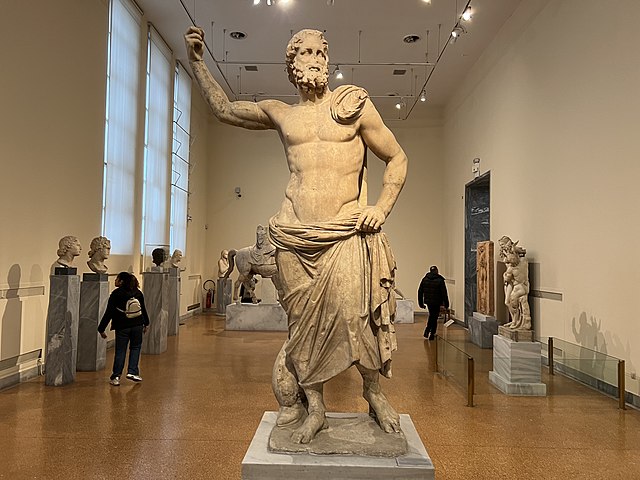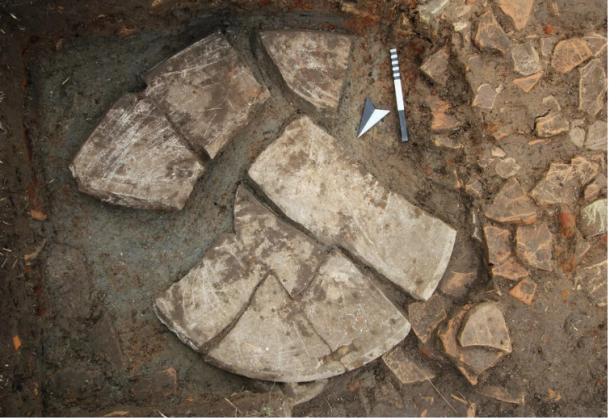ATHENS – Archaeologists from the Austrian Archaeological Institute (AAI) and the Greek Ministry of Culture have made significant strides in unearthing an ancient temple complex at Kleidi-Samikon in the western Peloponnese, Greece. The team recently uncovered the full length of the Temple of Poseidon, a discovery that redefines the understanding of this historical site.
Poseidon, the brother of Zeus and one of the twelve Olympian gods in ancient Greek mythology is known primarily as the god of the sea, storms, earthquakes, and horses. He is often depicted as a powerful, imposing figure holding a trident.

Statue of Poseidon with Parian marble. Found on Milos, a volcanic Greek island in the Aegean Sea. Photo Credit: Photo taken by www.PinterPandai.com in National Archaeological Museum, Athens, Greece. CCA-SA 3.0
Poseidon continues to be worshipped and venerated in numerous modern Pagan and polytheistic traditions.
The temple site is approximately 28 meters (~92 ft) long and nearly 9.5 meters wide (~31 ft), which is more monumental than previously anticipated. The sanctuary’s placement near the ancient fortress of Samikon and the coast—closer to the sea in antiquity—suggests it held both religious and strategic value. Notably, ancient historian Strabo once described a Poseidon temple “nestled in a grove of wild olive trees,” a description that aligns closely with this site. Its coastal proximity and fortified location indicate the temple’s dual role as a center for worship and a landmark of regional identity.
The sanctuary likely served as the religious and ethnic center for the Triphylian League, fostering a cultural bond among nearby cities. Its strategic location also facilitated control over a path through the swamps, underscoring its regional importance for centuries. Though now several kilometers inland, the temple site was once much closer to the sea affirming its connection to Poseidon.
In 2021, geophysical investigations uncovered hints of the temple’s ground plan beneath the ancient fortress of Samikon, but the new excavations reveal the full scale of the site.
In 2022, additional excavations verified the size of the site and the structure has been confirmed as a temple likely dedicated to Poseidon. The temple’s unique layout, with two main rooms and a vestibule, sets it apart from other known ancient Greek sanctuaries. Birgitta Eder, head of the Athens branch of the AAI, highlighted the distinctiveness of the temple’s design, remarking, “We are looking at an Archaic temple consisting of two main rooms…[and] so far, we know of no comparable buildings.” This unusual dual-room structure has led researchers to speculate that it may have served multiple functions, perhaps as a shared worship space for different deities or as a meeting place for that coalition of nearby cities.

Ritual purification vessel, found on site. The vessel cover 1 square meter (about 21 square feet) [Credit: Ministry of Culture ΥΠΠΟ)
Among the artifacts discovered is a bronze plaque bearing an inscription, likely once affixed to a temple wall. Due to its fragile condition, the plaque was carefully recovered and removed with the surrounding earth for preservation. X-ray imaging has revealed parts of an extensive inscription, and Eder expressed optimism about its historical value. She noted it might provide insights into the temple’s origins and regional significance.
Clearing vegetation north of the temple also uncovered a double-walled structure believed to have marked the sanctuary’s boundary, possibly serving as flood protection from nearby lagoons. The wall was originally identified by archaeologist Wilhelm Dörpfeld in the early 20th Century but had not been fully examined until now.
This year’s excavations also found fragments of an archaic marble vessel, the Perirrhanterion, used for ritual cleansing, found in the temple’s second room. The vessel has been nearly reconstructed to reveal its original one-meter diameter, and it shows signs of ancient repair with iron clamps—demonstrating the care with which sacred objects were maintained.
Additional evidence of the temple’s importance was discovered in roof tiles removed around 300 BCE and left inside the building, suggesting the temple’s abandonment or ritual decommissioning.
Scholars long suspected the Kleidi hills might hold Poseidon’s temple, and the current discovery is a milestone in the five-year project and those scholarly hypotheses. Future work will explore the sanctuary’s full extent and search for additional structures, such as altars, treasuries, or pathways.
Researchers plan to continue their work, hoping the plaque’s inscription and the reconstructed vessel will offer further insights into ancient religious practices and daily life in the region.
The Wild Hunt is not responsible for links to external content.
To join a conversation on this post:
Visit our The Wild Hunt subreddit! Point your favorite browser to https://www.reddit.com/r/The_Wild_Hunt_News/, then click “JOIN”. Make sure to click the bell, too, to be notified of new articles posted to our subreddit.